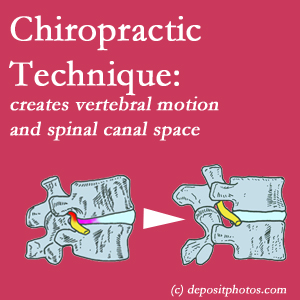February 2023 Healthy News from Satterwhite Chiropractic Spinal Canal Area Increase and Back Pain Reduction with Chiropractic Care

Degenerated disc. Spinal stenosis. Back Pain. What do they have in common…besides pain? Reduced spinal canal area. With disc degeneration, the disc reduces, resulting in reduced spinal canal area. With spinal stenosis, a(n) disc bulge, protruding disc, osteophyte, discal cyst, synovial cyst, spinal cyst affects the spinal canal area. A new paper detailed how chiropractic flexion distraction treatment, namely Cox® Technic spinal manipulation and mobilization, enlarged the spinal canal area and produced vertebral motions. The new study just published in January 2023 reported that chiropractic flexion distraction increased spinal area, height, and width due to increased nerve foraminal area. (1)
Such spinal changes made more space for involved spinal elements like spinal nerves to glide leading to eventual (though sometimes faster or even immediate for some patients) back pain relief. Outcomes and published research like this are the forces behind our use of gentle, safe chiropractic treatment approaches like Cox® Technic that has research explaining its biomechanical effects on the spine. Bring your stenotic spine and/or degenerated disc to Satterwhite Chiropractic for a pain-relieving treatment plan!
Listen to this PODCAST with Dr. Ram Gudavalli, the guiding researcher in Cox® Technic studies, on The Back Doctors Podcast with Dr. Michael Johnson as he describes the research behind The Cox® Technic System of Spinal Pain Management.

Back pain sufferers are frequently recommended exercises to strengthen spinal, gluteal, and core muscles as a way to round out their in-office chiropractic treatment. Classic lumbar flexion (Williams) exercises have been standard since the 1930s as they limit lumbar extension while enhancing lumbar flexion, supported by high levels of research evidence. A typical exercise sequence would have a patient lie on the floor, hands at the side, knees bent, then just tighten abdominal and gluteal muscles while flattening the spine against the floor. The following exercise would be a knee-chest motion (pulling one knee to chest then the other knee then both knees to chest) exercise. (2) There are more such exercises in the series, but we’d be excited for our new Oxford back pain patients to start with these simple moves on day 1 (after we go through a complete examinations and establish a treatment plan, of course). Satterwhite Chiropractic looks forward to talking soon about you and your spinal stenotic, disc degenerative spine and any exercises that may help!
CONTACT Satterwhite Chiropractic
Have a wonderful February! We anticipate seeing you and your spine this month!
